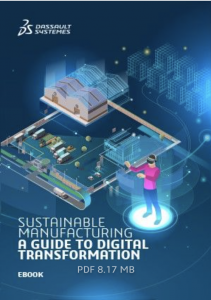
by Morgan Zimmermann, CEO of NETVIBES-EXALEAD
At Dassault Systèmes, we’ve identified a 21st-century Industry Renaissance, a profound societal transformation that, like the advent of the printing press during the European Renaissance, makes knowledge available to a wider audience. By making virtual experiences possible, digital technology is changing our world, just as the printing press did in the 15th century. As a result, we are undergoing a global Industry Renaissance, proliferating new ways, real and virtual, of inventing, learning, producing and trading.
Today, of course, virtual experiences are more top-of-mind than ever, with the novel coronavirus pandemic circling the globe and forcing people to find new ways to work and play. At the same time, other world problems, like climate change, remain pervasive. Because continuing to focus on short-term gains is not sustainable, we must use technological advances and public policy to commit to providing a more stable and sustainable environment, both in the workplace and on the home front.
The workforce of the future wants the planet to survive, but moreover to be a better place to live together; one that provides everyone a more balanced and enjoyable life. Sustainability is at the heart of this common goal. These desires are not new. But today’s industrial actors not aligning on sustainability have, or will have, difficulty finding employees and customers. Companies are increasingly evaluated less on their P&L than on their engagement with the three, inextricably linked, Ps of sustainability: people, planet, and profit.
The three Ps model is starting to have a massive influence on the industrial world. The United Nations is advocating its 17 Sustainable Development Goals, “a call for action by all countries—poor, rich and middle-income—to promote prosperity while protecting the planet.” Ranging from “Affordable and Clean Energy” to “Sustainable Cities and Communities”, the Goals “recognize that ending poverty [people] must go hand-in-hand with strategies that build economic growth [profit] and address a range of social needs [people] including education, health, social protection, and job opportunities, while tackling climate change and environmental protection [planet].”
Investment funds are actively endorsing the three P values when making investment decisions. And it’s not only small niche players. Major multinationals like U.S.-based global investment manager BlackRock, Inc. are offering sustainable investing solutions. In addition, companies of all sizes in all domains are adopting long-term policies. Market leaders such as Adidas, Danone, Gucci and L’Oréal recognize that strong sustainability initiatives are good business. Consumers are eager to invest in the products and services of companies that represent their values, and employees are eager to work there.
“Society is demanding that companies, both public and private, serve a social purpose. To prosper over time, every company must not only deliver financial performance, but also show how it makes a positive contribution to society.” – Laurence D. Fink, Chairman & CEO, BlackRock, Inc., 2018 Letter to CEOs
Right about now you’re probably thinking, “Why are the words ‘artificial intelligence’ in the title of this article? Are they just some kind of bait-and-switch tactic to grab my attention?” Here are some ideas about how AI will get us there quicker:
The United Nations organizes an annual AI for Good Global Summit. With its tagline of “Connecting AI innovators with problem owners for sustainable development,” the Summit is “the leading UN platform for global and inclusive dialogue on AI.” It aims to “identify practical applications of AI to accelerate progress towards the UN Sustainable Development Goals” and “ensure trusted, safe and inclusive development of AI technologies and equitable access to their benefits.”
In 2013, tech giant Google launched an annual $25M Google.org Impact Challenge, to which organizations of all sizes can submit concepts for how AI can be used to address and alleviate key societal challenges across the areas of environmental science, healthcare, and wildlife conservation. Grantees are awarded a strategic package of support including funding and Google volunteers.
Artificial intelligence is not a gimmick. It’s not simply for generating new music playlists or annoying chatbots that ultimately can’t answer your customer service questions! According to PwC, the global economy could see a potential contribution of $15.7tr from AI by 2030. Today AI is helping the world become more sustainable and helping businesses of all sizes stay ahead of the competition.
At Dassault Systèmes we’ve defined three main “pillars” to enable our customers to meet sustainability targets, all of which are strengthened by AI:
1. Workforce of the Future (People)
Mentioned above, the workforce of the future is about capturing and transferring knowledge and know-how from today’s employees, empowering people with technology to create experiences that spark innovation. These innovations can help build a more sustainable future, one that meets or even exceeds the UN Goals.
How does that work? Digital technology facilitates sharing information faster around the world. Companies must embrace a shift in skills to adapt to new technologies, and thus increase the autonomy of their workforce. This can be achieved via multidisciplinary approaches to life-long learning and training, combining the classroom and the laboratory.
How does AI contribute value? AI helps make actionable the best practices hidden in documents for any employee to leverage in order to make a greater impact on the enterprise. Thanks to AI, that knowledge can be delivered faster, at unimaginable scale and at the right time by using augmented/virtual reality, collaborative platforms and 3D, making training more intuitive. Thus, the workforce can make better informed decisions. The symbiotic relationship between AI and people makes them both smarter.
For example, the global agriculture industry must consider multiple complex and changing factors (crops, terrain, skills, climate, equipment, safety, and much more) in order to maximize output sustainably. A systematic approach combined with machine learning takes all of these factors into account in context to educate personnel around the world about how to best achieve their productivity goals while respecting the planet.
2. Global Operations Optimization (Planet)
By adopting lean practices throughout the product lifecycle, companies can minimize their global environmental footprint.
How does that work? This goes much further than solving problems on the shopfloor. It’s about evaluating and streamlining all operations, from product design to manufacturing engineering, production and supply chain optimization in a continuous feedback loop.
How does AI contribute value? Of the many topics that could be covered here, let’s touch on two:
- Elimination of waste is a core concern of manufacturing. The 7 Muda activities for potential waste have been defined by Toyota using the acronym TIMWOOD
- Transportation: Avoiding moving the product unnecessarily
- Inventory: Limiting overstock
- Motion: Decreasing movement of people/equipment
- Waiting: Eliminating needless waiting
- Over-processing: Preventing over-processing and waste
- Over-production: Avoiding over-production
- Defect: Decreasing errors and scrap
Getting rid of anything that doesn’t add value in these critical areas requires AI technology that can self-learn from constantly-evolving targets (sales, inventories, resources, capacity, etc.) AI can anticipate the most beneficial tradeoffs in order to limit waste.
- Reduction of energy consumption is another example where AI has proven its value. A lot of excitement is being generated around the implementation of intelligent networks that connect producers and consumers, maximizing the storage and just-in-time supply of energy. AI predicts consumption peaks and helps with real-time optimization of operations settings.
For example, UK-based water company United Utilities is set to roll out a network-wide energy flexibility platform incorporating AI. The platform “can assess vast amounts of data on a wide range of factors such as weather, demand for water, pump performance and electricity prices. This is used to help make decisions on the most cost-effective and efficient way to run pumps, detect burst pipes and minimise the risk of discoloured water.” A 12-week trial demonstrated impressive energy savings of 22 percent.
There is also great potential in research through machine learning enhanced prediction of new energy materials. For example, Berkeley Lab’s Materials Project combines machine learning with density functional theory calculations to identify promising new compounds. It has calculated over 50,000 electronic bandstructures thus far. The possibilities are endless.
3. Value Network Orchestration (Profit)
In today’s experience economy, the supply chain is being replaced by global value networks, industrial partners joining forces to redefine their contribution to achieving common delivery goals.
How does that work? Companies require collaborative tools that give them visibility into resources and processes and how they’re interconnected. If manufacturers adopt a value network model, they can better coordinate all stakeholders more efficiently in an agile manner. This creates sustainable value for the enterprise while delivering unique experiences to market.
How does AI contribute value? AI sifts through data at lightning speed, evaluating millions of potential scenarios to find the right information. People are able to propose and test the best scenarios, simulating outcomes to pinpoint the right opportunities and apply what they learn where it makes sense.
Collaborating through the value network can reduce waste and increase efficiency—from product and packaging design and raw-material sourcing, to disposal and recovery of materials. For example, two companies could share resources, such as spares, logistics or even inventories. AI helps them optimize capacity to become a self-adapting, more productive, production line.
Collaborative platforms are creating sustainability throughout the value network. A platform such as the 3DEXPERIENCE lets network members use a virtual experience twin to confirm which alternatives meet expectations. Firms can capture, standardize and analyze data to evaluate a business activity’s environmental and social impacts and communicate takeaways for informed decision-making. Testing ideas, products and the experiences they provide in the virtual world before actually producing them in the real world can lead to inventing new usages and the products supporting them.
In sum, Al is a catalyst for change related to arming the workforce of the future, optimizing global operations and orchestrating value networks, all profoundly human endeavors. The most challenging problem is deciding how we want to observe and live in the world; what is the referential to be used to connect and contextualize exponential amounts of data? We believe that only virtual worlds are able to provide the right observation and decision-making deck for manufacturing. By speeding access to virtual worlds, AI technology is making the real world more efficient. It not only delivers new insights and knowledge; it allows us to capture and understand experience and reuse it to improve the world, taking full advantage of the Industry Renaissance.
To learn more about how AI is improving sustainability in manufacturing:
- Read the Dassault Systèmes eBook: Sustainable Manufacturing: A Guide to Digital Transformation
- Read the DELMIA blog: “How to Make Manufacturing Sustainability a Strategic Priority”
- Read our announcement: Dassault Systèmes Names Alice Steenland Chief Sustainability Officer
Sources:
https://blogs.3ds.com/perspectives/what-is-industry-renaissance/
https://www.un.org/sustainabledevelopment/sustainable-development-goals/
https://www.pwc.com/gx/en/issues/data-and-analytics/publications/artificial-intelligence-study.html
https://www.manufacturingterms.com/Muda.html
https://materialsproject.org/about
Join our User Communities to stay on top of the latest industry news, ask questions and collaborate with peers:



